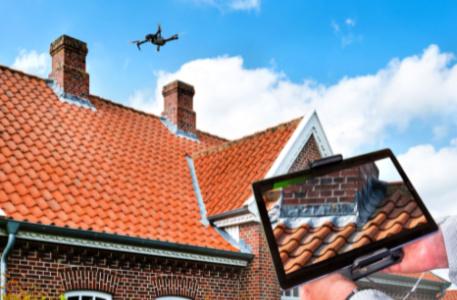
5 FAQs about Drones and Roof Inspections
For as long as people have built homes, it’s been vital to ensure we have solid roofs over our heads. However, the conventional way of inspecting roofs—on foot and using ladders—is giving way to drones, also called unmanned aerial vehicles (UAVs).
If you think you might benefit from a professional roof evaluation, potentially using a drone, consider these five points:
1. When are roof inspections necessary or helpful?
If you’re interested in buying a home, you probably want to ensure that you don’t encounter any expensive, unpleasant surprises after moving in. That’s why most homebuyers add an inspection clause in their purchase contract, which typically includes an evaluation of the roof.
The cost to repair or replace a roof can vary dramatically, so it’s best to know if you’re facing a significant expense before finalizing your purchase.
Once you own a home, there are also good reasons to get roof inspections. For example, if you install a new roof, you may need to have it examined periodically to protect a warranty.
Roof inspections can also help you keep tabs on its condition and spot potential drainage or leakage problems.
Or, if your roof is damaged in a storm, your insurance adjuster may order an inspection to help you file a claim.
Finally, if you decide to install solar panels, you will probably need an inspection to ensure your roof can support the panels and meets any local and state ordinances.
2. What do roof inspectors look for?
Roofs can be flat or sloped and are built with various materials, including asphalt and wood shingles, ceramic and clay tiles, and seamed metal. In the U.S., asphalt shingles are most common because they’re economical and easy to install. But all types of roofs can degrade over time.
Inspectors will look for signs of wear and tear that may lead to water leaks and structural damage. For example, cracked, curled, and missing shingles can be signs of trouble. In addition to checking the surface, inspectors can also evaluate ridgelines, gutters, soffits, and fascia.
Penetration points for vents, chimneys, or skylights should also be checked as potential sources of leaks. In addition, if debris has accumulated along roof valleys or gutters, it could mean that water is backing up and finding escape routes inside the roof.
For a complete understanding of how a roof is performing, inspectors also examine its interior side, among the rafters, for signs of leaks or structural damage.
3. What are the advantages of using drones for roof inspections?
Traditionally, roof inspectors climbed ladders or used binoculars to look at a roof’s condition. However, both approaches have their risks and limitations.
Roofs can be steep and slick. When an inspector walks on one, there’s always a risk of personal injury—and damage to the roof. Also, it may not be physically possible to get a visual inspection of some areas.
However, when an inspector uses a drone, it eliminates the need to walk on the roof or rely on binoculars. It also allows the inspector to record close-up images from every possible angle. As a result, the inspection is more thorough and less dangerous.
Drone inspections are usually faster since a drone can be positioned quickly, especially compared to physically accessing a roof, moving ladders, and taking various safety precautions.
4. Do all roof inspectors use drones?
No, but many do, and the practice is growing. Once a professional inspector has decided to invest in a drone and offer this service, they must do three things—learn how to operate the drone, secure a Remote Pilot Certificate, and register their UAV with the Federal Aviation Administration (FAA).
5. How much should I budget to inspect my roof?
The cost of roof inspections varies substantially, depending on where you are located, the difficulty of accessing your roof, and the type of inspection you want.
According to Fixr, a physical inspection ranges from $75 to $250, and drone inspections average $150 to $400.
Suppose you’re also interested in understanding how your roof may be leaking warm or cool air. In that case, you may be interested in including an infrared inspection, which uses a thermal imaging camera. According to Fixr, infrared inspections average $400 to $650.
